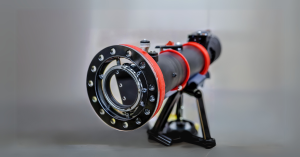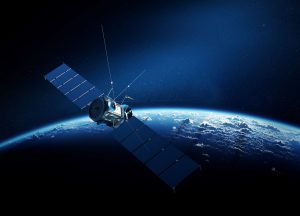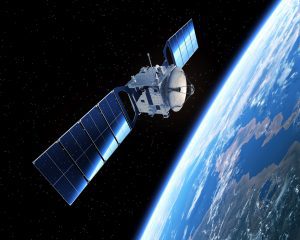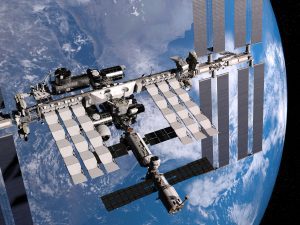Key takeaways
- Optics debris detection is essential for managing orbital debris, which includes over 40,500 pieces of space debris larger than 10 cm traveling at high speeds. These collisions pose severe risks to satellites.
- Advanced methods like laser ranging, LIDAR, and light sheet systems effectively track space debris.
- Avantier offers custom optics solutions tailored for detecting orbital debris, ensuring precision and reliability for satellite payloads. Our expertise makes high-performance optics accessible for addressing this growing challenge.
Orbital debris poses a very real risk to satellites and orbital spacecraft, and optics debris detection is the most effective way to mitigate that risk. Here we’ll examine how optical tracking, laser ranging and other methods can be used to determine the precise orbit of space debris. But first, why is space debris a problem?
Orbital Debris: An Emerging Problem
The low earth orbit was free of manmade objects until 1957, but since then, the number of small and large pieces of debris orbiting our planet has skyrocketed. Today, there are an estimated 40500 pieces of space debris larger than ten centimeters, and 130 million greater than 1 mm. Since these pieces of debris travel at speeds in the order of kilometers per second, collisions can be catastrophic. It has been estimated that a small coin traveling at 10/km/s can deliver the same impact as a small bus, traveling at 100 km/hr. Even small pieces of space debris, then, are too dangerous to be ignored.

Optics Debris Detection
Large pieces of space debris (with size greater than a meter) are cataloged and tracked from the ground using radar or simple optical methods. Radar provides a reliable method of following the orbits of space debris as they circle the earth, and can provide data accurate to within a few kilometers. This data can be relayed to the operators of any functional satellites who might be in danger of a collision.
Smaller pieces of space debris, though still dangerous, require more sophisticated optical methods or equipment that is mounted on LEO satellites.
In one type of basic orbital debris detection sensor setup suitable for use in space, a permanent light sheet is generated using a low power laser and conic mirror. Such a system could be designed to weigh no more than 2 kg, and have a size of about 10 cm x 10 cm x 20 cm, making it suitable for incorporation into a wide variety of satellite systems. The scattering, reflection, transmittance or absorbance of light that happens when a piece of orbital debris intersects the light sheet could be detected by a CCD camera fitted with a wide angle lens. A wide range of information can be gleaned from this setup, including information on the size and light scattering properties of the object.
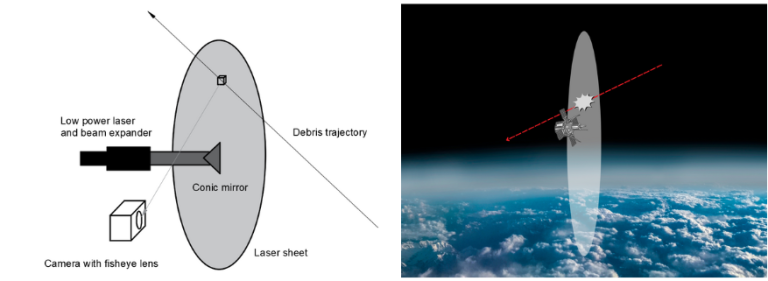
Precise orbital detection of mid-sized debris can also be achieved using carefully designed orbital laser ranging and LIDAR techniques. Often passive optical means and solar illumination are used to first recognize a piece of space debris, which is then illuminated with an intense ns-pulsed TOF laser. The receiver telescope is equipped with single photon detectors, capable of detecting backscattered photons. This detection method has been used to detect objects of as little as 10 cm in diameter, and typical ranging accuracy is about 3 m rms.
Space Debris Detection at Avantier
Avantier’s experienced optical design team has specialized in high performance custom optics, and are familiar with the unique requirements of satellite payloads as well as the highly specialized optics needed to map space debris from the ground. Though high quality custom optical components and systems typically require a long turnaround and high budget, our in-house state of the art manufacturing equipment and dedicated team allow us to make these optics as accessible as possible to you, with as short a turnaround possible.
We can work with you from any stage of the process, whether you have a tested design ready to go or need help figuring out how to make your ideas work. Contact us today to place your custom order or set up an initial consult.
- Bennet, Rigaut, Ritchie, & Smith. (2014). Adaptive Optics to Enhance Tracking of Space Debris. SPIE, https://spie.org/news/5541-adaptive-optics-to-enhance-tracking-of-space-debris
- Englert et al (2014). Optical Orbital Debris Spotter. Acta Astronautica, Volume 104 Issue 1, https://www.sciencedirect.com/science/article/pii/S0094576514002872
- ESA (2024) Space Debris by the Numbers. https://www.esa.int/Space_Safety/Space_Debris/Space_debris_by_the_numbers
- NASA. (2018) Orbital Debris Management and Risk Mitigation. Academy of Program/Project & Engineering Leadership. https://www.nasa.gov/wp-content/uploads/2018/12/692076main_orbital_debris_management_and_risk_mitigation.pdf?emrc=e20460
GREAT ARTICLE!
Share this article to gain insights from your connections!


